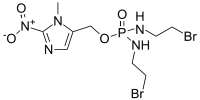All AbMole products are for research use only, cannot be used for human consumption.

TH-302 is a 2-nitroimidazole triggered hypoxia-activated prodrug of the cytotoxin bromo-isophosphoramide mustard (Br-IPM). TH-302 inhibits H460 cells and HT29 cells with IC90 of 0.1 μM and 0.2 μM, respectively. TH-302 exhibits potent cytotoxicity to both human and murine MM cells with hypoxic selectivity and dose dependency, and induces G0/G1 cell-cycle arrest under hypoxic conditions. TH-302 treatment resulted in a reduction in the volume of the HF 48 hours after dosing and a corresponding increase in the necrotic fraction. TH-302 is currently in a phase II clinical trial for the treatment of soft tissue sarcoma.

Drug Deliv. 2020 Dec;27(1):1412-1424.
Hypoxic targeting and activating TH-302 loaded transcatheter arterial embolization microsphere
TH-302 (Evofosfamide) purchased from AbMole

Bioorg Chem. 2020 Jun;99:103778.
Development and Biological Investigations of Hypoxia-Sensitive Prodrugs of the Tyrosine Kinase Inhibitor Crizotinib
TH-302 (Evofosfamide) purchased from AbMole

Eur J Med Chem. 2018 Oct 5;158:51-67.
Structure-activity relationship study of hypoxia-activated prodrugs for proteoglycan-targeted chemotherapy in chondrosarcoma
TH-302 (Evofosfamide) purchased from AbMole

PLoS One. 2017 Jul 13;12(7):e0181340.
Development and characterization of a human three-dimensional chondrosarcoma culture for in vitro drug testing
TH-302 (Evofosfamide) purchased from AbMole
| Cell Experiment | |
|---|---|
| Cell lines | H460, H82, DU145, A375 and PC3 cells line |
| Preparation method | In vitro cytotoxicity assay Exponentially growing cells were seeded 24 hours before the addition of test compounds. After drug addition, the plates were incubated for 2 hours, or longer if indicated, under defined oxygen concentrations at 37°C in an anaerobic chamber (Bactron II), a hypoxia chamber (Hypoxystation), or a standard tissue-culture incubator. Using this method, cells equilibrated rapidly (<30 minutes) with the gas phase as shown by linearity of time course of cytotoxicity and use of dissolved oxygen probe (OxyLite, Oxford Optronics). Cells were cultured for 72 hours in complete medium after washing under normoxic conditions, and the viable cells were quantified using AlamarBlue. For DPI experiments, cells were pretreated with 100 μmol/L of DPI for 2 hours under air. Drug concentration resulting in growth inhibition of 50% (IC50) relative to untreated control was calculated using Prism software. |
| Concentrations | 0~100µM |
| Incubation time | 2h |
| Animal Experiment | |
|---|---|
| Animal models | PLC/PRF/5, hepatocellular carcoma (HCC) xenograft model with NCI SCID female mice |
| Formulation | saline (0.9% NaCl) |
| Dosages | 50 mg/kg, QD 5/wk*2 wks |
| Administration | intraperitoneally |
| Molecular Weight | 449.04 |
| Formula | C9H16Br2N5O4P |
| CAS Number | 918633-87-1 |
| Solubility (25°C) | DMSO ≥ 60 mg/mL |
| Storage |
Powder -20°C 3 years ; 4°C 2 years In solvent -80°C 6 months ; -20°C 1 month |
| Related Products |
|---|
| Gadoteric acid
Gadoteric acid is a macrocyclic, paramagnetic, gadolinium-based contrast agent that can be used for magnetic resonance imaging (MRI) of the brain, spine, and related tissues. Gadoteric acid is able to detect and visualize areas of blood-brain barrier disruption and abnormal vascular distribution. |
| Sulfo-SANPAH
Sulfo-SANPAH is a primary amine-nitrobenzene azide cross-linker. Sulfo-SANPAH is a heterobifunctional crosslinker that contain an amine-reactive N-hydroxysuccinimide (NHS) ester and a photoactivatable nitrophenyl azide. |
| 2-Deoxy-2-fluoro-D-glucose
2-Deoxy-2-fluoro-D-glucose is a radiolabeled glucose analog, which is commonly used in medical imaging techniques such as positron emission tomography (PET) scans. |
| 2-Bromo-4-chlorophenylacetic acid
2-Bromo-4-chlorophenylacetic acid is a biochemical reagent. |
| CPN-351 TFA
CPN-351 TFA is a selective pentapeptide antagonist of human NMUR1 with a pA2 of 7.35. CPN-351 TFA can be used for the research of inflammation. |
All AbMole products are for research use only, cannot be used for human consumption or veterinary use. We do not provide products or services to individuals. Please comply with the intended use and do not use AbMole products for any other purpose.


Products are for research use only. Not for human use. We do not sell to patients.
© Copyright 2010-2024 AbMole BioScience. All Rights Reserved.
